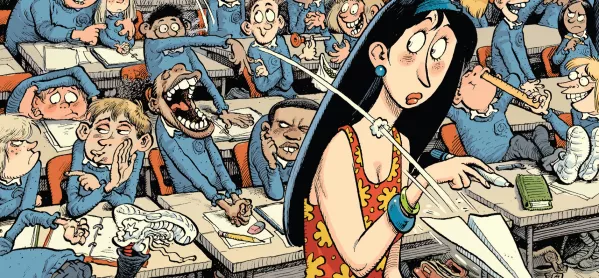- Home
- Low-level disruption: 6 ways to stop the rot
Low-level disruption: 6 ways to stop the rot

The following could be mind-bogglingly obvious to many readers but I present here strategies I’ve used over the years to combat that most frustrating of classroom challenges; low-level disruption.
In teaching, you can get the class from hell, the class from heaven or the many classes in-between, but all of them have the capacity to master the art of low-level disruption. They slip “under the radar” of grand sanctions, they never do “enough” to warrant a class report or for parents to be called in, but every lesson with them is really hard work.
It’s little conversations here and there when you’re talking: too many for you to deal with in the moment. It’s shouting out when you’re trying to explain, not from one or two but from nearly all students, meaning warnings are scattered around the class rather than targeted at any one individual. It feels like they get away with it every lesson and you just go away feeling shattered for following the school disciplinary policy to the letter.
It’s these lessons, on a regular basis, that burn teachers out and often aren’t prioritised in a busy school with so many competing priorities.
Here are a few things I’ve done over the years that have helped me on the day to day (maybe you already do most of them, but there might be something here to help):
1. Tactical manoeuvring
When giving an instruction or explanation, physically move to stand next to the students who you feel are most likely to disrupt. Your mere presence there can sometimes be enough.
2. Vary the activities
From “chalk and talk” to paired and small group learning - activities that involve listening, speaking and talking - these help to keep attention peaked. Pace is important in teaching and although keeping things ticking along and changing the pace won’t solve the problem of low-level disruption, in my experience, it can at least limit opportunities for students to switch off.
3. Seating plans
Seating is probably the most powerful tool at your disposal. First, the obvious one, seat potentially disruptive students out of each other’s eye lines and as far apart as possible. Consider rows rather than pods for a class where low level disruption can be a major hurdle. I always caveat seating plan announcements to students with “this will likely change within weeks once I get to know you, I always like to switch seating several times throughout the year”. Sometimes I don’t, but keeping students on their toes is helpful.
4. Target individuals
In the case of the whole class talking - a blanket of noise - I always try to calmly target key individuals with sanctions, addressing them by name firmly (but avoid shouting). It can be really tough to stay calm in these situations and avoid a whole class “dressing down” but in my experience, this should settle the class, it may take a few moments (or even a few minutes) where it feels like control has gone but keep going through the sanctions with those individuals until the whole class complies.
5. Pre-starter on the desks
Having something for students to do as they walk in focuses minds instantly. I tend to usually line them up outside (classroom management starts as soon as they appear) - ask them to come into the room in silence (use sanctions where appropriate if they won’t do that). Then I would concentrate on making sure every single student is doing what’s been asked of them, praising those that are by name. I would stand at the front and middle of the room while they are doing this so you can see all students, walking around might mean my back is turned and I miss something. Having something quick and easy to do for those that are finished is essential for me and being on to them from the word go: “If you finish, please let me know.” Of course, all this might work for me but not for you, which is one of the joys of teaching, how complex and contextual it truly is.
6. Give clear instructions
One of the most common causes of low-level disruption is when students are unsure of exactly what they need to do. This is why I try to concentrate on giving concise and clear explanations (often repeated several times but in different ways) BEFORE students start a given task. A random trick I picked up years ago, which strangely works for me, is to pick a point on the wall above students’ heads while giving the explanation and look at that whilst delivering it. I know that sounds ridiculously random, but I read it in a book years ago and it can work. So can lowering your voice to the minimal audible level so students really need to listen to your voice to hear what you’re saying.
Hopefully, there’s something here for you to try. Of course, insist on support from those with the responsibility to help. And the great thing about teaching is that there’s always a colleague ready to support: it isn’t a weakness to ask for their help.
Thomas Rogers is a teacher who runs rogershistory.com and tweets @RogersHistory
For more columns by Tom, view his back catalogue
Keep reading for just £1 per month
You've reached your limit of free articles this month. Subscribe for £1 per month for three months and get:
- Unlimited access to all Tes magazine content
- Exclusive subscriber-only stories
- Award-winning email newsletters



